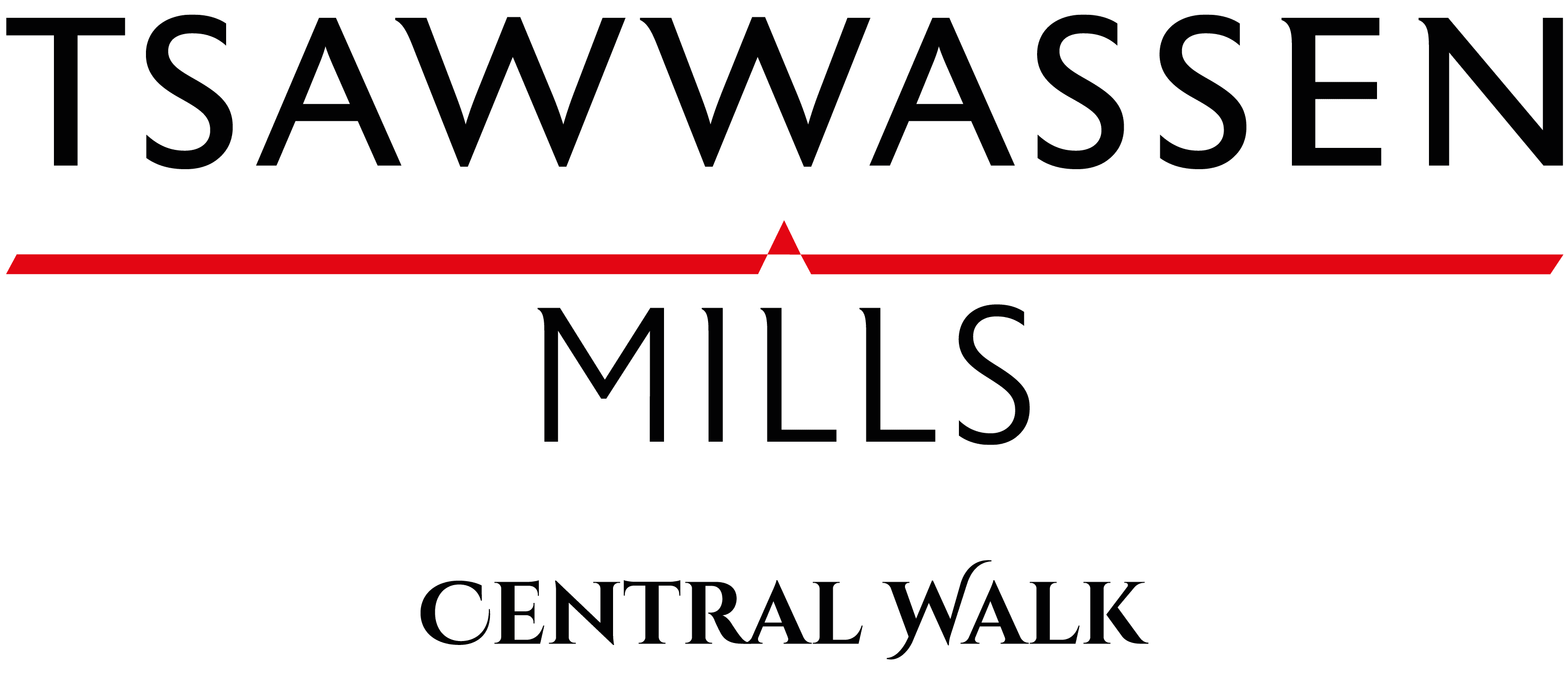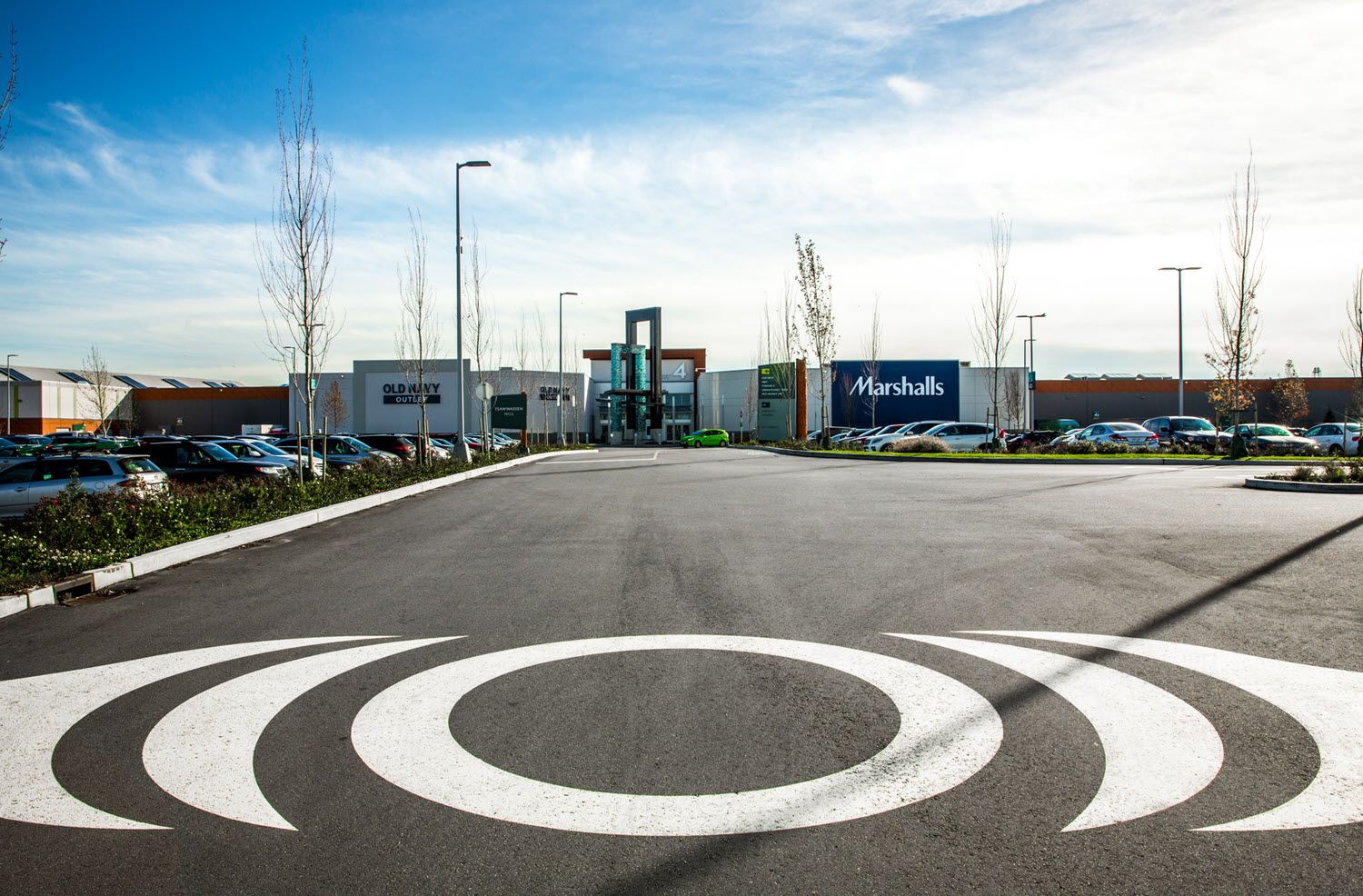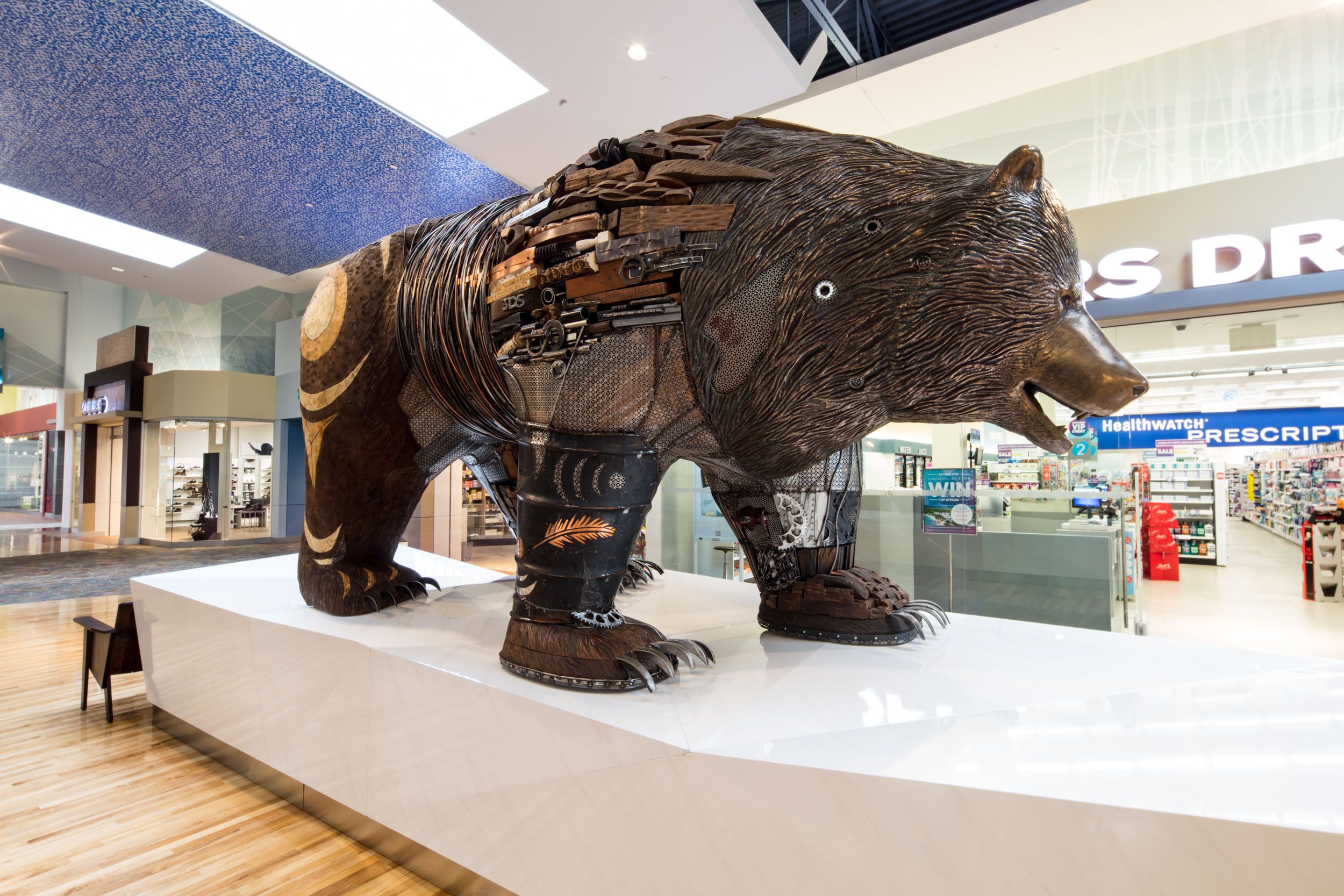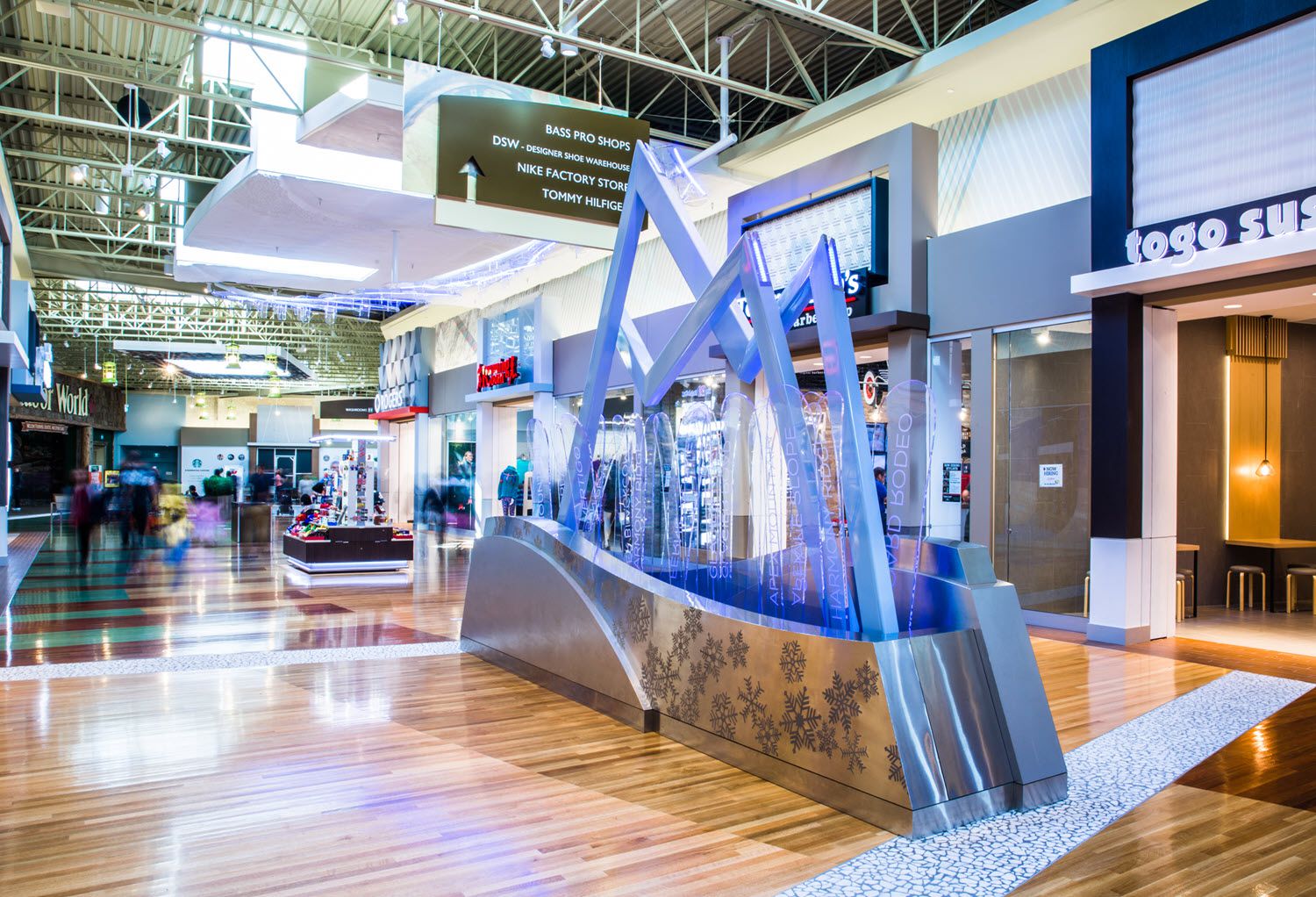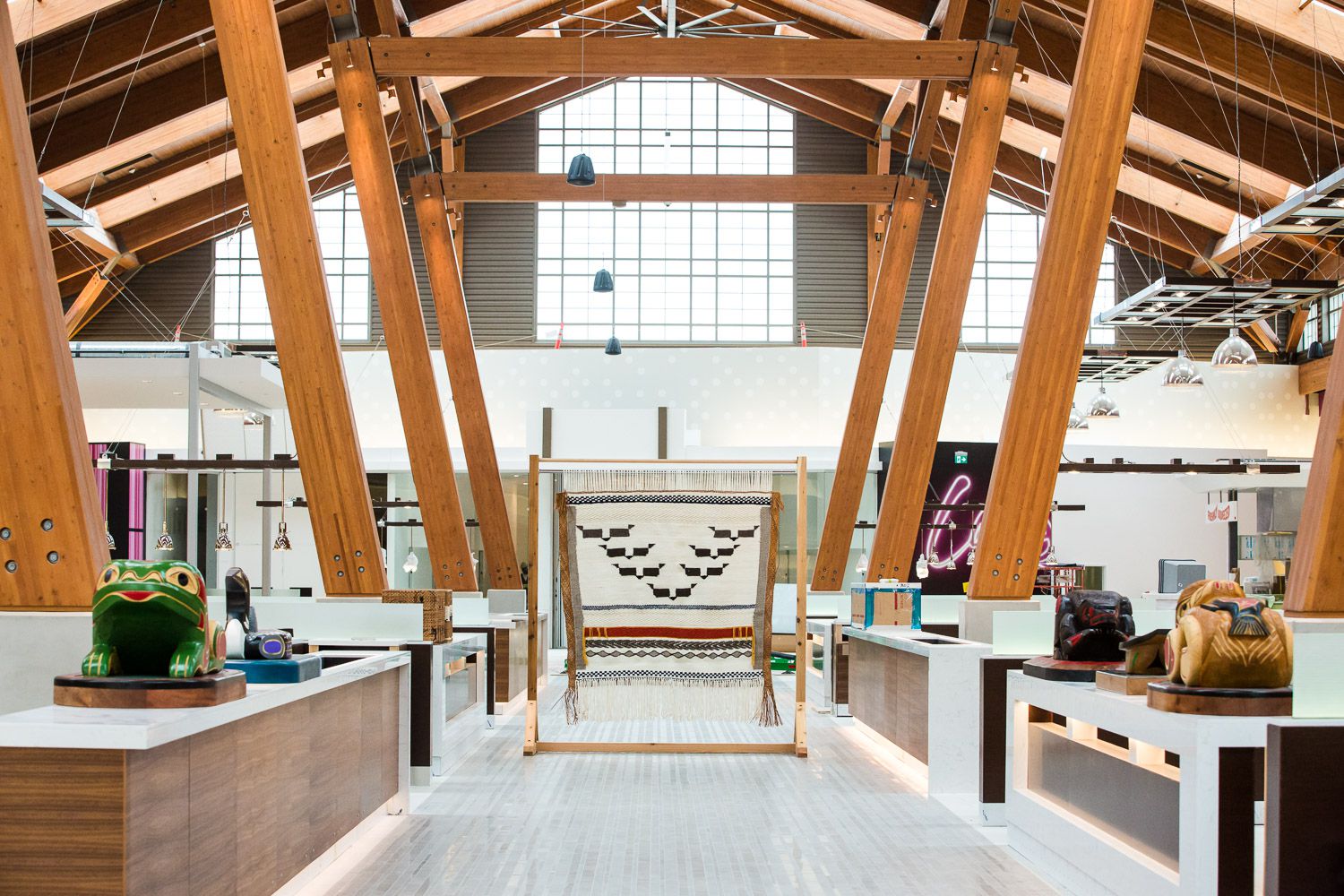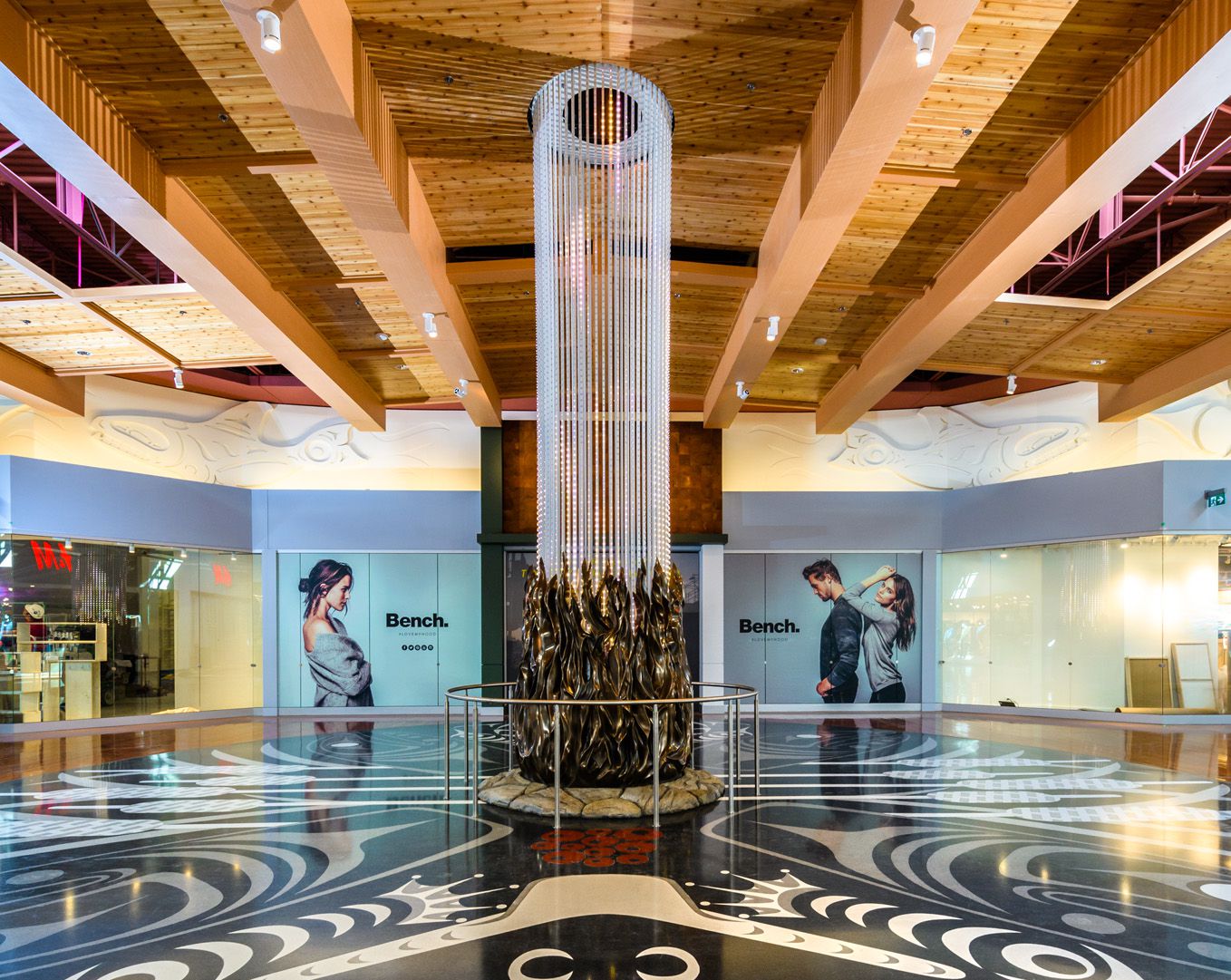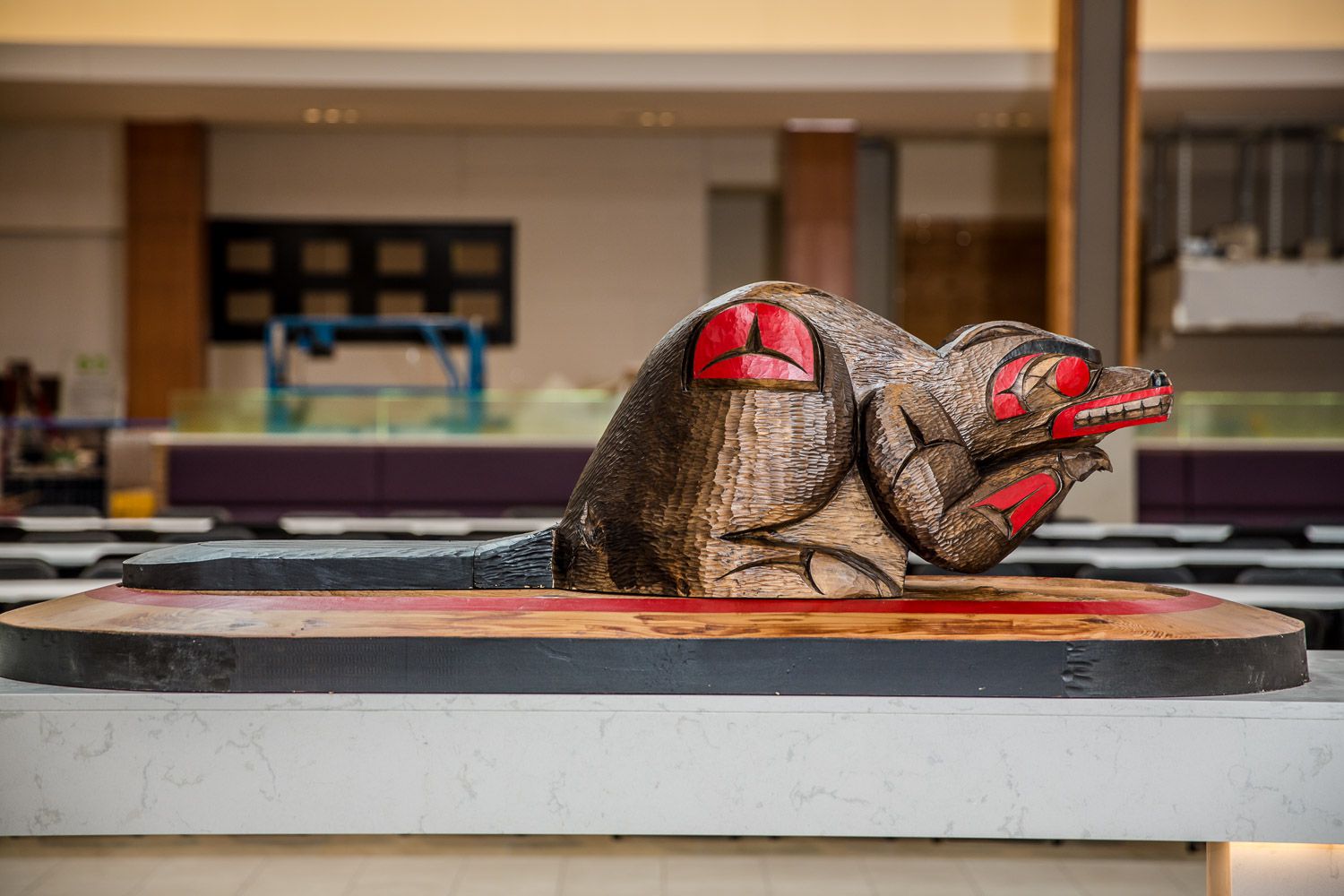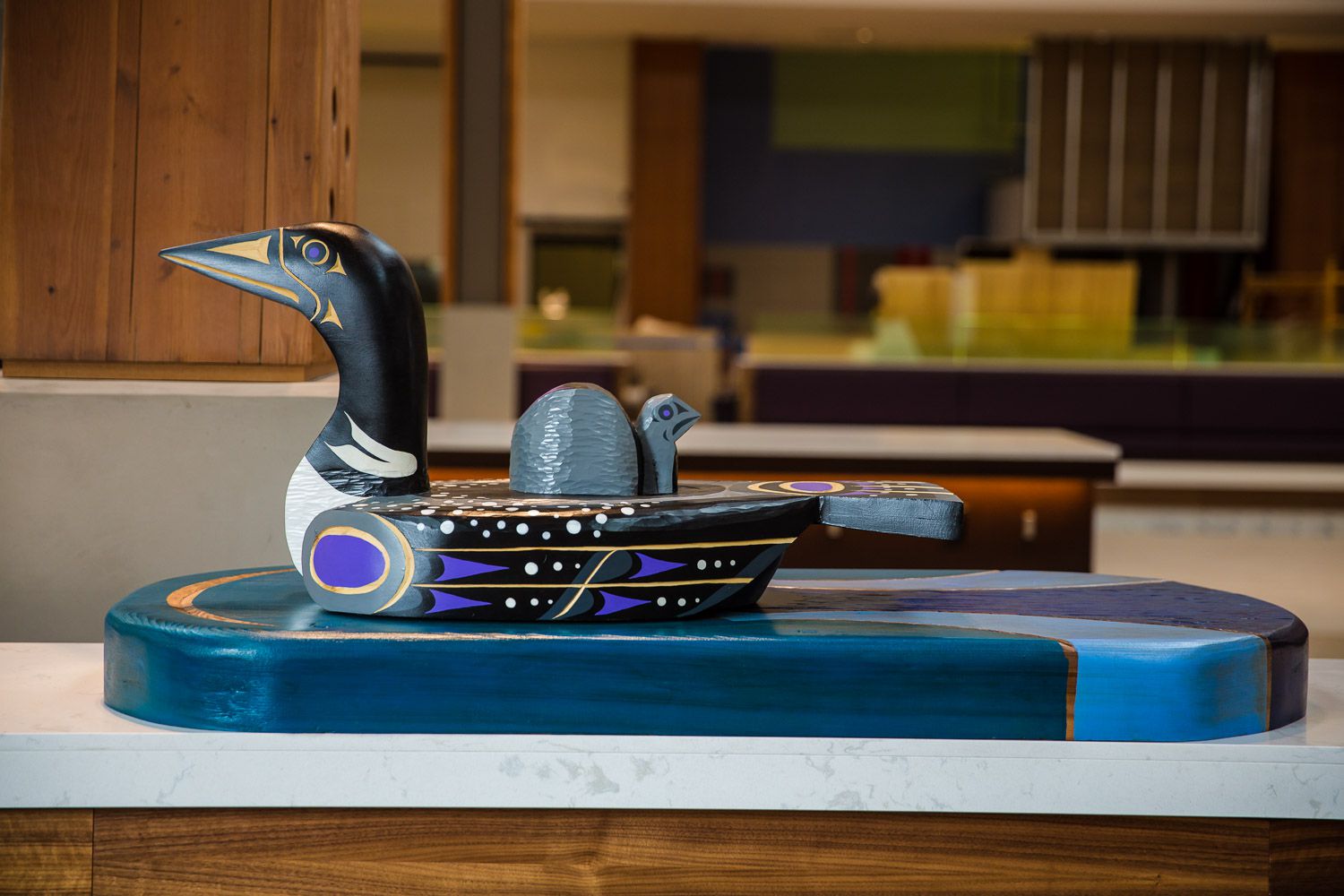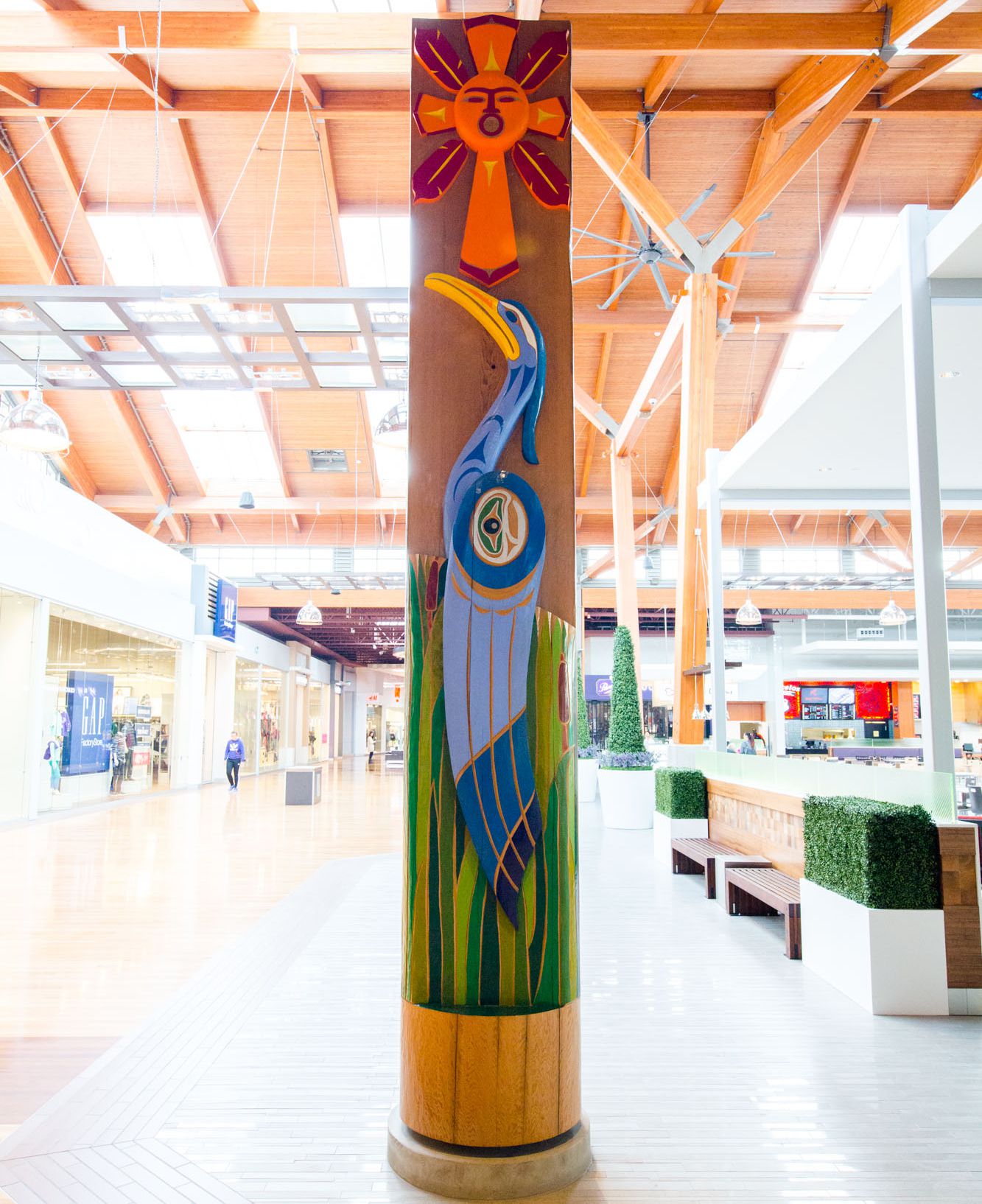Discover 22 art installations throughout our Centre that tell the authentic story of the BC region through exclusive art pieces by Tsawwassen First Nation artists.
Click here for a printable copy of our Artwalk brochure and take a self guided tour.
For additional details of each artwork, please see below.
Bollard Stamp
Using the three basic geometric elements for Coast Salish design: the trigon, circle, and crescent. Bryce Williams created a stamp that has been used as a graphic element to adorn posts and walkways at Tsawwassen Mills. The use of geometric symmetry in Coast Salish...
THE RAVEN SPINDLE WHORL
Spindle whorls were often carved with images of animals, geometrics or other symbolic images. On this spindle whorl the Raven signifies creation and knowledge. The spindle and its accompanying whorl comprise a simple, elegant tool that has been used for spinning...
Bear
The Bear portrays the abstract idea of Tsawwassen’s local animals in nature from the perspective of an artist. The collage and assembly of a wide variety of materials represent the viewpoints of several types of artists: photographer, sculptor, metalworker, wood...
Bikes
The concept behind these pieces are outdoor activities representing various Vancouver recreational activities, such as hiking, snowboarding, rock climbing, fishing, cycling and rowing. Some of these pieces on the ceiling and floor specifically name several trails,...
Outdoor Life – Sports
The concept behind these pieces are outdoor activities representing various Vancouver recreational activities, such as hiking, snowboarding, rock climbing, fishing, cycling and rowing. Some of these pieces on the ceiling and floor specifically name several trails,...
Grass Icon
The concept behind the Grass Icon is the farmlands and open fields. This piece stands prominent and strong and the design highlights the contrast of nature and man-made. The steel represents the human force imposed on the land and will continuously corrode and rust...
Eyes of Our Ancestors Weaving
This traditional weaving of wool and cedar pays homage to the elders of the Tsawwassen Nation. They are a source of inspiration and guidance for many in our community. They also are the memory of our community, they preserve and pass on our language, our culture and...
Fishing Weir Bench
This bench was designed to portray a fishing weir. A fishing weir is an obstruction placed in tidal waters, or wholly or partially across a river, to direct the passage of, or trap fish. A weir may be used to trap marine fish in the intertidal zone as the tide...
Whale & Salmon Wall Graphics
Tsawwassen First Nation are proud, sea-faring Coast Salish people. For thousands of years, we traveled and fished the waterways of the southern Strait of Georgia and lower Fraser River, visiting all Canadian and U.S. Gulf Islands. Our ancestors were accomplished...
Contemporary Paddles
Traditional carved paddles were used to steer and paddle the large cedar canoes in the coastal waters. Native paddles are also used during ceremonial dances. Paddles were also used as deadly weapons in the past. First Nations paddles are often carved and painted with...
Fish Icon
Visitors to Tsawwassen Mills are greeted as they enter the Coast Salish Neighbourhood by the stunning view of these two, leaping salmon, historically important symbols of the Tsawwassen First Nation local culture. The artists explored various shapes, orientation, and...
Central Hearth
The hearth is a central element of the Coast Salish people which is often found in the centre of many traditional homes or villages. The fire was kept alight and formed the focal point for the First Nations family. It was the place where food was prepared and shared...
Stylized Geese & Designs
These stylized ceiling shapes represent flying geese. The flying geese have also been incorporated into the traditional weaving “Eyes of our Ancestors” which is also displayed in the mall. Located in front of H&M - See map below. Artist Loretta Williams Loretta is...
Sun & Moon Spindle Whorls
Spindle whorls were used by the Coast Salish people for the creation of textiles. Spindle whorls were often carved with images of animals, geometrics or other symbolic images. This stylised spindle whorl depicts the sun on one side and the moon on the other. These...
Feast Bowl & Ladle
This feast bowl and ladle are inspired by our First Nation Culture. All First Nation people pride themselves on feasting with their guests, and any social event. Traditionally in their longhouses, they would have used these large feast bowls for soups and stews. The...
Woven Baskets
Inspirations behind these baskets: “Our Journey Canoe, Nation to Nation” Basket We once travelled far and wide from nation to nation on our sacred canoe. As we travelled on our almighty cedar, it gave us protection on our journey to our sacred house of healing. When...
Beaver
This beaver was carved by Frank Raymond Campbell. Beavers signify family, determination and creativity. They can be seen making dams and fishing on Tsawwassen First Nations lands. Located at the Food Hall - See map below. Artist Frank Raymond Campbell Frank was born...
Otter & Salmon
The otter and salmon is part of Jody Wilson’s creations for Tsawwassen Mills. The otter and salmon signify trust and loyalty; they can often be seen along the coast while fishing. Located at the Food Hall - See map below Artist Jody Wilson Jody is a Coast Salish...
Frog
The frog is one of Jody Wilson’s creations for Tsawwassen Mills. The Frog signifies a time of change from winter to spring when Salmon started swimming up river. Located at the Food Hall - See map below. Artist Jody Wilson Jody is a Coast Salish native, grew up in...
Loon
Karl Morgan created this figurine in its natural setting. "The loon signifies peace, tranquility and generosity. The loon was inspired by the beauty of my wife and daughter who are inseparable, amazing, and will always have each other’s back." – Karl Morgan Located at...
House Post
Coast Salish People traditionally carve house posts. The house post tells the significance of land they rest on. The Tsawwassen Mills house post tells the story of the success of the Tsawwassen First Nation (TFN) treaty which came into effect April 3, 2009 allowing...
Sea to Sky – Progressive Art Shapes
“My split ‘U’ design is a common shape used in our cultural art formation. The design helps configure our animals, I incorporated a killer whale and an Eagle. I named this piece ‘Sea to Sky’ because we come from the Salish seas where the killer whales swim. The sky...
Progressive Art Bench
Rest your feet while sitting at a contemporary version of progressive art shape seating bench. The shape of the bench is designed based on Coast Salish figures. Located near the Food Hall - See map below. Artist Bryce Williams Bryce is a Haida and Coast Salish artist...
City Icon
The outside view from this entry represents the Vancouver skyline with tall architectural elements. The designers incorporated the typical Downtown Vancouver green/blue glass mosaic found on the coast. This similar pattern and color scheme continues within the City...
As the City Spins Around You
"My Vancouver is very different from your Vancouver. My Vancouver is based on where I work, where I shop, where I live, where my friends are. We all live in our own versions of the city. And how interesting would it be to paint different versions of Vancouver as...
Wolf
With a style to compliment the other artwork pieces 3DS created for Tsawwassen Mills, the original faceted wolf idea was customized by the fabricators through incorporating some First Nations inspired artwork onto the wolf’s exoskeleton. To give the wolf more...
Herons
The Herons portray the abstract idea of Tsawwassen’s local animals in nature from the perspective of an artist. The collage and assembly of a wide variety of materials represent the viewpoints of several types of artists: photographer, sculptor, metalworker, wood...

